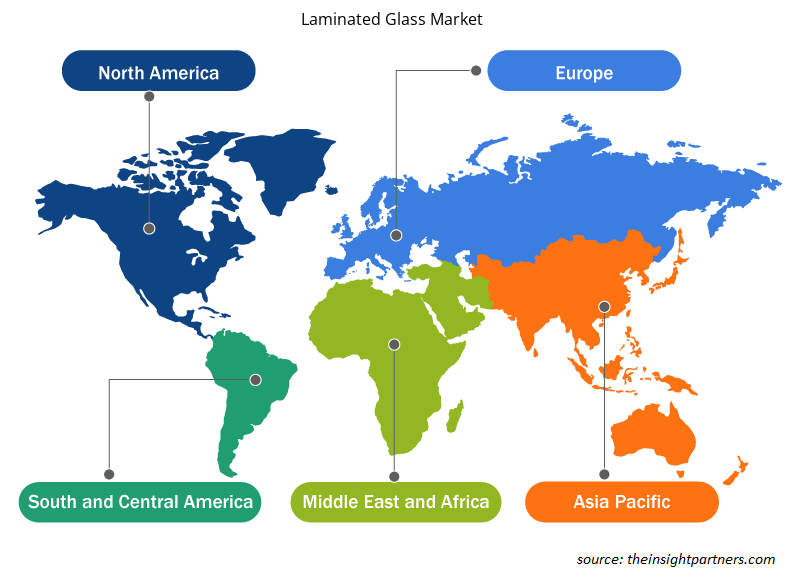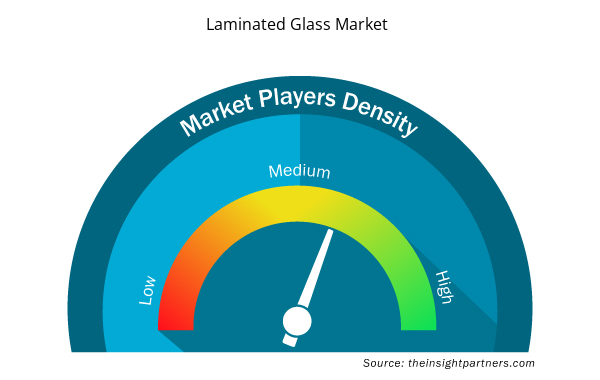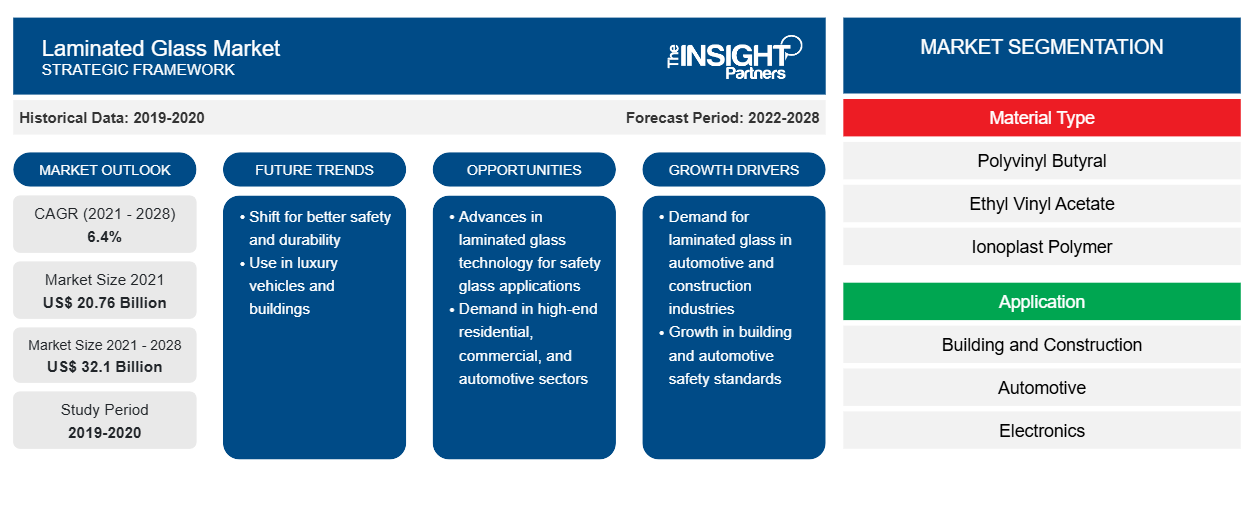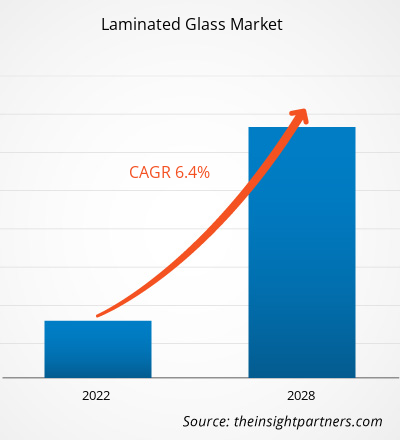적층 유리 시장은 2021년 207억 6천만 달러에서 2028년 321억 달러로 성장할 것으로 예상되며, 2021년에서 2028년까지 연평균 성장률 6.4%로 성장할 것으로 예상됩니다.
적층 유리는 여러 겹의 열 강화 또는 강화 유리에 압력과 열을 가하여 제조됩니다. 적층 유리는 중간층으로 분리됩니다. 중간층은 충격을 받았을 때 유리 파편을 함께 고정하는 데 도움이 됩니다. 유리는 건축 및 건설, 자동차, 전자 제품과 같은 산업에서 광범위하게 사용됩니다.
2020년 아시아 태평양 지역은 글로벌 적층 유리 시장 에서 가장 큰 매출 점유율을 차지했습니다 . 주거 및 상업 건설 프로젝트의 증가는 이 지역 시장 성장에 기여하는 주요 요인입니다. 이에 따른 건설 산업의 성장은 이 지역의 적층 유리 수요를 촉진하고 있습니다. 게다가 아시아 태평양 지역은 자동차 산업이 주도적이며 모든 지역 중에서 가장 높은 차량 생산을 기록합니다. 적층 유리는 자동차 산업의 윈드실드 커버에 광범위하게 사용되어 적층 유리 제조업체에 유리한 사업 기회를 창출합니다.
귀하의 요구 사항에 맞게 이 보고서를 사용자 정의하세요
이 보고서의 일부 또는 국가 수준 분석, Excel 데이터 팩을 포함하여 모든 보고서에 대한 사용자 정의를 무료로 받을 수 있으며 신생 기업 및 대학을 위한 훌륭한 혜택과 할인 혜택을 이용할 수 있습니다.
- 이 보고서의 주요 시장 동향을 알아보세요.이 무료 샘플에는 시장 동향부터 추정 및 예측까지 다양한 데이터 분석이 포함됩니다.
코로나19 팬데믹이 적층 유리 시장에 미치는 영향
COVID-19 팬데믹은 봉쇄, 여행 금지, 사업 중단으로 인해 다양한 국가의 경제와 산업에 영향을 미쳤습니다. 화학 및 재료 산업은 공급망 중단 및 생산 공장 폐쇄와 같은 심각한 결과를 겪은 주요 산업 중 하나였습니다. 적층 유리 시장 부족은 2021년까지 지속될 것으로 예상되어 다양한 사업에 중단을 초래할 것입니다. 또한 많은 공장과 제조업체가 유리 생산을 중단하거나 늦춰야 했기 때문에 현재 수요를 충족하기가 매우 어려웠습니다. 건설 산업은 유리 부족의 주요 희생자였습니다. 폐쇄 기간 동안 주민들은 시간과 돈을 모두 투자하여 집을 재건하거나 리모델링하여 자재 수요를 촉진했습니다. 게다가 유리 조달의 어려움으로 인해 적층 유리 사업은 상당한 침체를 겪었습니다. 따라서 COVID-19 팬데믹 동안 최종 사용자 산업의 수요가 낮아 적층 유리 시장 성장이 둔화되었습니다.
시장 통찰력
건축 및 건설 산업에서의 응용 프로그램 증가로 적층 유리 시장 성장 촉진
건축 및 건설 산업에서 적층 유리에 대한 수요는 구조적 요소로서 유리의 사용이 증가하고 보다 창의적인 건축 디자인에 대한 선호도가 높아짐에 따라 상당한 추진력을 얻었습니다. 주류 건축 프로젝트에서 구조적 요소로서 유리를 사용하는 것이 점점 더 인기를 얻고 있습니다. 적층 유리는 건축 및 건설 산업에서 다양한 실내 및 실외 응용 분야에서 광범위하게 사용됩니다. 게다가 현대적 디자인의 안전성과 내구성을 높여줍니다. 주택과 상업용 건물을 안전하게 유지해야 할 필요성으로 인해 안전 유리 및 기타 유리 제품에 대한 수요가 증가했습니다.
애플리케이션 인사이트
응용 프로그램을 기준으로 글로벌 적층 유리 시장은 건물 및 건설, 자동차, 전자, 태양광 패널 등으로 세분화됩니다. 건물 및 건설 부문은 2020년에 시장에서 가장 큰 점유율을 차지했습니다. 적층 유리는 강도와 깨지지 않는 특성으로 인해 주거 및 상업용 건물에 널리 사용됩니다. 적층 유리는 소음 차단 특성으로 인해 호텔, 공항 터미널 및 녹음 스튜디오에서 점점 더 많이 사용되고 있습니다. 특히 아시아 태평양과 같은 신흥 지역에서 건물 및 건설 산업의 성장은 향후 몇 년 동안 적층 유리에 대한 수요를 증가시킬 가능성이 높습니다.
글로벌 라미네이트 유리 시장의 몇몇 주요 시장 참여자로는 Asahi India Glass Limited, Cardinal Glass Industries, Inc., Central Glass Co., Ltd., Fuyao Group, Guardian Glass Llc, Press Glass Sa, Saint Gobain SA, Schott Ag, Taiwan Glass Group, Xinyi Glass Holdings Limited가 있습니다. 시장에서 활동하는 참여자는 고객 요구 사항을 충족하기 위해 고품질의 혁신적인 제품 제공을 개발하는 데 중점을 두고 있습니다.
스포트라이트 보고서
- 적층 유리 시장의 진보적인 산업 동향은 플레이어가 효과적인 장기 전략을 개발하는 데 도움이 됩니다.
- 선진국과 개발도상국 시장에서 채택한 사업 성장 전략
- 2019년부터 2028년까지의 적층 유리 시장에 대한 정량적 분석
- 적층 유리에 대한 세계 수요 추산
- 산업에서 운영되는 구매자와 공급자의 효율성을 설명하기 위한 포터의 5가지 힘 분석
- 경쟁 시장 시나리오를 이해하기 위한 최근 개발
- 적층 유리 시장 성장을 주도하고 제한하는 요인과 더불어 시장 동향 및 전망
- 상업적 이익을 뒷받침하는 시장 전략을 강조하여 의사 결정 과정을 지원하고 시장 성장을 이끕니다.
- 다양한 노드에서의 적층 유리 시장 규모
- 시장의 자세한 개요 및 세분화, 그리고 적층 유리 산업 역학
- 성장 가능성이 유망한 다양한 지역의 적층 유리 시장 규모
적층 유리 시장 지역 통찰력
Insight Partners의 분석가들은 예측 기간 동안 적층 유리 시장에 영향을 미치는 지역적 추세와 요인을 철저히 설명했습니다. 이 섹션에서는 북미, 유럽, 아시아 태평양, 중동 및 아프리카, 남미 및 중미의 적층 유리 시장 세그먼트와 지리에 대해서도 설명합니다.

- 적층 유리 시장에 대한 지역별 데이터 얻기
적층 유리 시장 보고서 범위
| 보고서 속성 | 세부 |
|---|---|
| 2021년 시장 규모 | 207억 6천만 달러 |
| 2028년까지 시장 규모 | 321억 달러 |
| 글로벌 CAGR (2021-2028) | 6.4% |
| 역사적 데이터 | 2019-2020 |
| 예측 기간 | 2022-2028 |
| 다루는 세그먼트 | 재료 유형별
|
| 포함된 지역 및 국가 | 북아메리카
|
| 시장 선도 기업 및 주요 회사 프로필 |
|
시장 참여자 밀도: 비즈니스 역학에 미치는 영향 이해
적층 유리 시장은 소비자 선호도의 변화, 기술 발전, 제품의 이점에 대한 인식 증가와 같은 요인으로 인해 최종 사용자 수요가 증가함에 따라 빠르게 성장하고 있습니다. 수요가 증가함에 따라 기업은 제품을 확장하고, 소비자의 요구를 충족하기 위해 혁신하고, 새로운 트렌드를 활용하여 시장 성장을 더욱 촉진하고 있습니다.
시장 참여자 밀도는 특정 시장이나 산업 내에서 운영되는 회사나 기업의 분포를 말합니다. 주어진 시장 공간에 얼마나 많은 경쟁자(시장 참여자)가 존재하는지 그 규모나 총 시장 가치에 비해 나타냅니다.
적층 유리 시장에서 운영되는 주요 회사는 다음과 같습니다.
- 아사히 인디아 글라스 리미티드
- 카디널 글라스 인더스트리 주식회사
- 센트럴글라스 주식회사
- 푸야오 그룹
- 가디언 글라스 유한회사
면책 조항 : 위에 나열된 회사는 어떤 특별한 순서에 따라 순위가 매겨지지 않았습니다.

- 적층 유리 시장 주요 업체 개요 알아보기
적층 유리 시장 세분화:
재료 유형
- 폴리비닐부티랄
- 에틸 비닐 아세테이트
- 이오노플라스트 폴리머
- 지방족 TPU
- 기타
애플리케이션
- 건축 및 건설
- 자동차
- 전자제품
- 태양광 패널
- 기타
회사 프로필
- 아사히 인디아 글라스 리미티드
- 카디널 유리 산업 주식회사
- 센트럴글라스(주)
- 푸야오 그룹
- 가디언 글래스 유한회사
- 프레스 유리 Sa
- 생 고뱅 SA
- 쇼트 주식회사
- 대만 유리 그룹
- 신의유리홀딩스유한공사.
- 역사적 분석(2년), 기준 연도, CAGR을 포함한 예측(7년)
- PEST 및 SWOT 분석
- 시장 규모 가치/양 - 글로벌, 지역, 국가
- 산업 및 경쟁 환경
- Excel 데이터 세트



Report Coverage
Revenue forecast, Company Analysis, Industry landscape, Growth factors, and Trends

Segment Covered
This text is related
to segments covered.

Regional Scope
North America, Europe, Asia Pacific, Middle East & Africa, South & Central America

Country Scope
This text is related
to country scope.
자주 묻는 질문
Increasing usage of laminated glass in building & construction industry along with associated advantages of laminated glass are the key factors driving the market growth over the forecast period. With the increasing use of glass as a structural element and the preference for more creative architecture designs, the demand for laminated glass in the building & construction industry has gained significant momentum. The laminated glass has various advantageous features which includes safety, security, reduced noise pollution, reduced emissions, UV control, durability, weather/natural disasters protection, and design versatility. Thus, growing prospectus in constructing modern buildings and structures coupled with its beneficial advantages drives the laminated glass market over the forecast period.
In 2020, China held the largest market share in the global laminated glass market. China is the world’s largest vehicle market across the globe, as per the International Trade Administration (ITA). The Chinese government has taken several initiatives for automobile manufacturers for augmenting the production capacity of the country to 35 million by 2025. The growing prospects of construction industry in China is further fueling the market growth. For instance, in 2019, the government of China had invested US$ 1.9 billion in 13 public housing projects. Thus, increasing construction activities and automotive production is anticipated to propel the laminated glass market in China in the coming years.
In 2020, the polyvinyl butyral (PVB) segment accounted for the largest market share. The growth of the segment is primarily attributed to its tough and ductile interlayers which makes it an excellent sound insulator. The PVB interlayer joins with both layers of the glass and holds it together to produce one strong and uniform layer. As the bond between the PVB sheet and the glass is a chemical bond, it does not shatter easily. Thus, wide scope application in automotive industry for windshields applications, PVB segment is augmenting the market growth.
On the basis of application, automotive segment is the fastest growing segment. Laminated glass is most widely used in car windshields in the automotive industry. It provides various advantageous features such as high strength, soundproofing, resistance to shattering, and security. As laminated glass does not shatter, it minimizes the risk of cuts and injuries and ensures the safety of the driver and passengers. Thus, growing adoption of laminated glass in the automotive industry is projected to drive the market growth over the forecast period.
The major players operating in the global laminated glass market are Asahi India Glass Limited, Cardinal Glass Industries, Central Glass Co., Ltd., Fuyao Group, Guardian Glass LLC, PRESS GLASS SA, Saint-Gobain, Schott AG, Taiwan Glass Ind. Corp, and Xinyi Glass Holdings Co., Ltd.
In 2020, Asia Pacific accounted for the largest share of the global laminated glass market. Rapid development in construction & automotive industry has propelled the demand of laminated glass in the region. In addition, growing investments by governments in infrastructural development projects such as airports, and public transit systems is driving the demand for laminated glass in Asia Pacific region.
Trends and growth analysis reports related to Chemicals and Materials : READ MORE..
The List of Companies - Laminated Glass Market
- Asahi India Glass Limited
- CARDINAL GLASS INDUSTRIES, INC
- Central Glass Co., Ltd
- Fuyao Group
- GUARDIAN GLASS LLC.
- PRESS GLASS SA
- SCHOTT AG
- SAINT GOBAIN S.A.
- Taiwan Glass Group
- Xinyi Glass Holdings Limited
The Insight Partners performs research in 4 major stages: Data Collection & Secondary Research, Primary Research, Data Analysis and Data Triangulation & Final Review.
- Data Collection and Secondary Research:
As a market research and consulting firm operating from a decade, we have published and advised several client across the globe. First step for any study will start with an assessment of currently available data and insights from existing reports. Further, historical and current market information is collected from Investor Presentations, Annual Reports, SEC Filings, etc., and other information related to company’s performance and market positioning are gathered from Paid Databases (Factiva, Hoovers, and Reuters) and various other publications available in public domain.
Several associations trade associates, technical forums, institutes, societies and organization are accessed to gain technical as well as market related insights through their publications such as research papers, blogs and press releases related to the studies are referred to get cues about the market. Further, white papers, journals, magazines, and other news articles published in last 3 years are scrutinized and analyzed to understand the current market trends.
- Primary Research:
The primarily interview analysis comprise of data obtained from industry participants interview and answers to survey questions gathered by in-house primary team.
For primary research, interviews are conducted with industry experts/CEOs/Marketing Managers/VPs/Subject Matter Experts from both demand and supply side to get a 360-degree view of the market. The primary team conducts several interviews based on the complexity of the markets to understand the various market trends and dynamics which makes research more credible and precise.
A typical research interview fulfils the following functions:
- Provides first-hand information on the market size, market trends, growth trends, competitive landscape, and outlook
- Validates and strengthens in-house secondary research findings
- Develops the analysis team’s expertise and market understanding
Primary research involves email interactions and telephone interviews for each market, category, segment, and sub-segment across geographies. The participants who typically take part in such a process include, but are not limited to:
- Industry participants: VPs, business development managers, market intelligence managers and national sales managers
- Outside experts: Valuation experts, research analysts and key opinion leaders specializing in the electronics and semiconductor industry.
Below is the breakup of our primary respondents by company, designation, and region:

Once we receive the confirmation from primary research sources or primary respondents, we finalize the base year market estimation and forecast the data as per the macroeconomic and microeconomic factors assessed during data collection.
- Data Analysis:
Once data is validated through both secondary as well as primary respondents, we finalize the market estimations by hypothesis formulation and factor analysis at regional and country level.
- Macro-Economic Factor Analysis:
We analyse macroeconomic indicators such the gross domestic product (GDP), increase in the demand for goods and services across industries, technological advancement, regional economic growth, governmental policies, the influence of COVID-19, PEST analysis, and other aspects. This analysis aids in setting benchmarks for various nations/regions and approximating market splits. Additionally, the general trend of the aforementioned components aid in determining the market's development possibilities.
- Country Level Data:
Various factors that are especially aligned to the country are taken into account to determine the market size for a certain area and country, including the presence of vendors, such as headquarters and offices, the country's GDP, demand patterns, and industry growth. To comprehend the market dynamics for the nation, a number of growth variables, inhibitors, application areas, and current market trends are researched. The aforementioned elements aid in determining the country's overall market's growth potential.
- Company Profile:
The “Table of Contents” is formulated by listing and analyzing more than 25 - 30 companies operating in the market ecosystem across geographies. However, we profile only 10 companies as a standard practice in our syndicate reports. These 10 companies comprise leading, emerging, and regional players. Nonetheless, our analysis is not restricted to the 10 listed companies, we also analyze other companies present in the market to develop a holistic view and understand the prevailing trends. The “Company Profiles” section in the report covers key facts, business description, products & services, financial information, SWOT analysis, and key developments. The financial information presented is extracted from the annual reports and official documents of the publicly listed companies. Upon collecting the information for the sections of respective companies, we verify them via various primary sources and then compile the data in respective company profiles. The company level information helps us in deriving the base number as well as in forecasting the market size.
- Developing Base Number:
Aggregation of sales statistics (2020-2022) and macro-economic factor, and other secondary and primary research insights are utilized to arrive at base number and related market shares for 2022. The data gaps are identified in this step and relevant market data is analyzed, collected from paid primary interviews or databases. On finalizing the base year market size, forecasts are developed on the basis of macro-economic, industry and market growth factors and company level analysis.
- Data Triangulation and Final Review:
The market findings and base year market size calculations are validated from supply as well as demand side. Demand side validations are based on macro-economic factor analysis and benchmarks for respective regions and countries. In case of supply side validations, revenues of major companies are estimated (in case not available) based on industry benchmark, approximate number of employees, product portfolio, and primary interviews revenues are gathered. Further revenue from target product/service segment is assessed to avoid overshooting of market statistics. In case of heavy deviations between supply and demand side values, all thes steps are repeated to achieve synchronization.
We follow an iterative model, wherein we share our research findings with Subject Matter Experts (SME’s) and Key Opinion Leaders (KOLs) until consensus view of the market is not formulated – this model negates any drastic deviation in the opinions of experts. Only validated and universally acceptable research findings are quoted in our reports.
We have important check points that we use to validate our research findings – which we call – data triangulation, where we validate the information, we generate from secondary sources with primary interviews and then we re-validate with our internal data bases and Subject matter experts. This comprehensive model enables us to deliver high quality, reliable data in shortest possible time.


 이 보고서에 대한 무료 샘플을 받으세요
이 보고서에 대한 무료 샘플을 받으세요